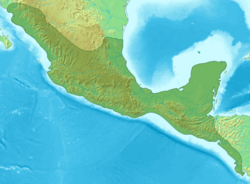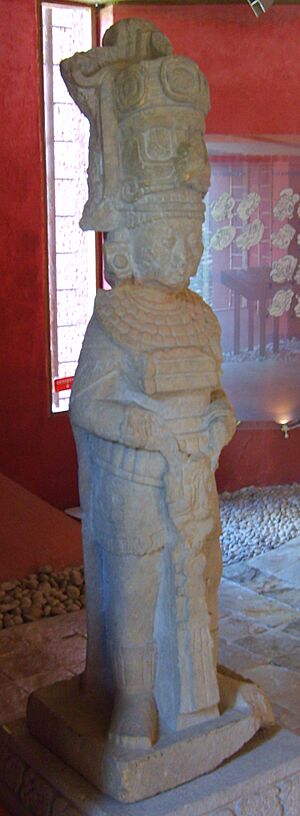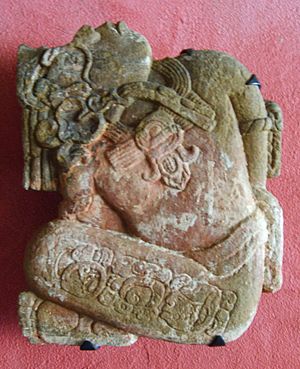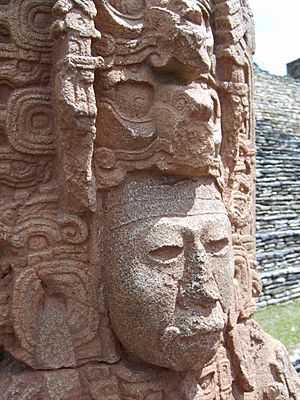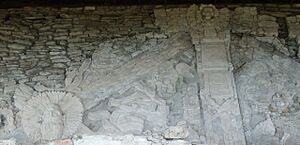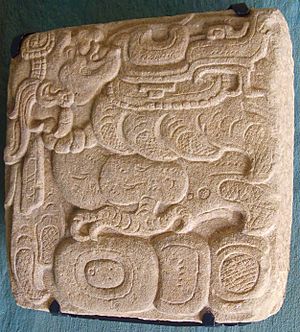Toniná facts for kids

A pyramid on the 5th terrace of the Acropolis at Toniná.
|
|
| Location | Ocosingo |
|---|---|
| Region | Chiapas, Mexico |
| Coordinates | 16°54′4.39″N 92°0′34.83″W / 16.9012194°N 92.0096750°W |
| History | |
| Abandoned | 10th century AD |
| Periods | Classic |
| Cultures | Maya |
| Site notes | |
| Excavation dates | 1972–1975, 1979-1980+ |
| Archaeologists | Pierre Becquelin, Claude Baudez, Juan Yadeun INAH |
| Architecture | |
| Architectural styles | Classic Maya |
| Responsible body: INAH | |
Toniná (pronounced Toh-nee-NAH) is an amazing ancient city built by the Maya civilization. It's now a ruined site in the Mexican state of Chiapas, not far from the town of Ocosingo.
This medium-to-large site features impressive temple-pyramids that rise high on terraces. There's also a big court for playing the Mesoamerican ballgame. Over 100 carved stone monuments, mostly from the 6th to 9th centuries AD, tell stories of its past.
Toniná is special because of its well-preserved stucco sculptures. It also has many unique, round carved monuments. These are like full statues, a style not often seen since the much older Olmec civilization. Toniná even boasts one of Mexico's largest pyramids, standing 74 metres (243 ft) tall! That's taller than the famous Pyramid of the Sun at Teotihuacan.
During the Late Classic period, Toniná was a powerful kingdom. It often fought wars to grow its influence. For a long time, it battled Palenque, its biggest rival. Eventually, Toniná became the most important city in the western Maya region.
The city is also famous for having the very last known Long Count date on any Maya monument. This date, AD 909, marks the end of the Classic Maya period.
Contents
What Does Toniná Mean?
The name Toniná means house of stone in the Tzeltal language. This is spoken by the local Maya people. Another idea is that it means the place where stone sculptures are raised to honor time.
However, "Toniná" is a modern name. The city's original name was likely Po or Popo. This name appears in ancient Maya texts for the kings of Toniná. They were called k'uhul po' ajaw, meaning "Divine Lord of Po."
Where is Toniná Located?
Toniná sits high up in the Chiapas Highlands of southern Mexico. It's about 40 miles (64 km) south of Palenque, its long-time rival.
The city is built on a limestone ridge. This made it easy to defend. It's also next to a seasonal river that flows into the Río Jataté.
Who Were the Rulers of Toniná?
Many kings ruled Toniná over the centuries. Their names and stories are carved into the city's monuments. Here are some of the important rulers:
| Name | Ruled | What they were known for |
|---|---|---|
| Ruler 1 | ? | One of the earliest known rulers. |
| B'alam Ya Acal | 6th century | Acceded to the throne in 568. |
| K'inich Hix Chapat | c. 595–665 | Installed other lords, ruled for a long time. |
| Ruler 2 | 668–687 | Known for warfare and showing captives. |
| K'inich B'aaknal Chaak | 688–715 | Restored Toniná's power, won battles against Palenque. |
| Ruler 4 | 708–723 | A young ruler who captured Palenque's king. |
| K'inich Ich'aak Chapat | 723–739+ | Fought against Piedras Negras. |
| K'inich Tuun Chapat | to 762 | May have renewed warfare with Palenque. |
| Ruler 8 | c. 787–806+ | A successful warrior king, called "He of Many Captives." |
| Uh Chapat | c. 837 | Ruled during Toniná's decline. |
| Ruler 10 | c. 901 | One of the last known rulers. |
The very last date recorded at Toniná is January 15, 909 CE. This is found on a monument called Monument 101.
Toniná's History: A Look Back
Early Years of Toniná
Toniná was active even in the Early Classic period. However, most of its early buildings are buried under later ones. This means we don't have many texts from this time. One text from the 8th century mentions a king ruling in AD 217.
Ruler 1 is shown on some early monuments, like an altar from 514. Another ruler, Jaguar Bird Peccary, is on a 6th-century stone slab. It says he became king in 568.
The first time another city mentioned Toniná was in 573. A text from Chinikiha, a city far away, talks about capturing someone from Toniná.
Toniná in the Late Classic Period
Toniná's history becomes clearer in the Late Classic period. More hieroglyphic texts from this time tell us about its kings and battles.
K'inich Hix Chapat's Reign
In 633, K'inich Hix Chapat appointed two lords to help him rule. He probably became king in 595. Not much else is known about his time as ruler. The last mention of him is on a stone from 665.
Ruler 2 and Warfare
Ruler 2 became king of Toniná in 668. His rule was full of warfare. His monuments often show bound captives, meaning prisoners of war. He started the style of carving statues in the round, which became typical for Toniná.
Ruler 2's reign might have ended when he was defeated by K'inich Kan Balam II of Palenque in 687. This event was recorded in Palenque and likely led to his sacrifice.
K'inich B'aaknal Chaak: A Powerful King
K'inich B'aaknal Chaak became king in 688 and ruled for 27 years. He brought Toniná back to power with many military wins over Palenque. His rule was mostly about fighting Palenque for control of the region.
Ballcourt 1, the larger of Toniná's two ballcourts, was opened in 699. This celebrated three victories against Palenque. The ballcourt originally had six sculptures of bound captives. These were lords from the Palenque king's area.
Ruler 4 and the Capture of Palenque's King
Ruler 4 became king in 708 when he was very young. Just three years later, in 711, Toniná won a huge victory over Palenque. This battle led to the capture of Kan Joy Chitam II, the king of Palenque. This made Toniná the most powerful city in its region.
The victory was so complete that Palenque had a ten-year gap in its royal history. The captured king might have been held hostage. Ruler 4 continued to rule, celebrating important dates in 716 and 721. One of his monuments shows a captive from Calakmul, a very powerful Maya city.
K'inich Ich'aak Chapat's Rule
K'inich Ich'aak Chapat took over from Ruler 4 in 723. Around 725, Toniná fought a war against Piedras Negras, a city in Guatemala. He marked several events on monuments between 726 and 729. In 730, he honored the tomb of K'inich B'aaknal Chaak.
Interestingly, during K'inich Ich'aak Chapat's reign, there are no sculptures of bound war captives. We don't know why this is.
Later Kings and Toniná's Decline
Not much is known about the next two rulers. K'inich Tuun Chapat, Ruler 6, celebrated a period ending in 736. He may have died in 762. A damaged text suggests more fighting with Palenque during his rule.
Ruler 7, possibly a woman named Lady K'awil, died in 774. In 775, a prince named Lord Wak Chan K'ak' died before he could become king.
Ruler 8 was the last of Toniná's successful warrior kings. He celebrated many events between 789 and 806. This included defeating Pomoy and capturing its ruler. Ruler 8 also rebuilt parts of the Acropolis. He put up many sculptures of war prisoners and called himself aj b'olon b'aak, meaning "He of Many Captives."
However, Toniná's power was starting to shrink. Its victory over Sak Tz'i', an important city, was in an area Toniná used to completely control.
By the time Uh Chapat became king, Toniná was clearly getting weaker. Only one event from his rule, in 837, is known. A stucco mural from his time shows captives with ropes around their necks.
Toniná's history continued even after most other Classic Maya cities had fallen. This might be because it was quite isolated. Ruler 10 is linked to a monument from 904. A monument from 909 has the last known Long Count date, but the king's name is missing. People lived at the site for another century or more, based on pottery found there.
Special Ritual: Cremation of Rulers
Archaeologists made an amazing discovery in the Temple of the Sun at Toniná. They found urns with the ashes of Maya rulers. These urns also contained rubber, coal, and roots. These are the same materials used to make the rubber balls for the Mesoamerican ballgame!
This suggests that the Maya people in Toniná honored their dead rulers in a unique way. They might have mixed their ashes into the rubber balls used in the important ballgame.
Toniná in Modern Times
The first written account of Toniná was by Fray Jacinto Garrido in the late 1600s. Many explorers visited the ruins in the 1800s. Guillaume Dupaix led an expedition in 1808. John Lloyd Stephens and Frederick Catherwood came in 1840. Stephens wrote a detailed description of the site.
Later, Eduard Seler and Caecilie Seler-Sachs studied the monuments. Karl Sapper visited in 1895 and 1896. Frans Blom and Oliver La Farge explored the site in the 1920s.
The French Toniná Project started digging here in 1972. They continued until 1975, then again from 1979 to 1980. The National Institute of Anthropology and History of Mexico (INAH) began its own excavations the next year.
Today, Toniná is open for visitors. It has a small museum that opened on July 15, 2000.
Exploring the Ancient City of Toniná
The city was built on a large platform. The main buildings are in the acropolis, which is like a big hill with seven terraces. It rises 71 metres (233 ft) above the plaza below. Toniná's buildings have a very clear, straight-line design.
Many of the carvings at Toniná show how fiercely the city treated its enemies. A huge stucco sculpture, 16 by 4 metres (52 by 13 ft), shows a skeleton death god. A frieze (a long band of sculpture) on the fifth terrace likely showed Toniná's most important victims. Many pieces of this frieze were found in the plaza. It was carved from local sandstone, but in the style of Palenque. This suggests that captured artists might have done the work.
After the city was abandoned, many sculptures fell down the steep terraces.
Important Buildings at Toniná
- Ballcourt 1 (also called the Sunken Ballcourt) was opened in 699. King K'inich B'aaknal Chaak dedicated it to celebrate three wins over Palenque. Sculptures of six captured lords from Palenque were used as markers in the ballcourt.
- Ballcourt 2 is smaller and sits at the foot of the Acropolis.
- The Palace of the Underworld has three arched entrances. These are on the second terrace of the Acropolis.
- The Palace of Frets is on the fourth terrace. Its south side has four large, stepped designs called frets. Inside, one room has stucco decorations of feathered serpents and crossed bones.
Amazing Sculptures and Monuments
The monuments at Toniná are often smaller than those at other Maya sites. Most of the stone slabs, called stelae, are less than 2 metres (6.6 ft) tall. What makes them special is that they are carved all around, like full statues. They often have hieroglyphic text running down their backs. On the fifth terrace, statues of Toniná's kings stood over carvings of their defeated enemies.
The dated monuments at Toniná cover most of the Classic Period, from AD 495 to 909.
- Monument 3 is a statue of a ruler. It describes K'inich Baaknal Chaak becoming king.
- Monument 5 is a life-size human statue, but its head is missing.
- Monument 7 is a stone base with well-preserved hieroglyphs. K'inich Ich'aak Chapat dedicated it in 728.
- Monument 8 is from Ruler 2's time. It shows three war captives being presented.
- Monument 12 is a statue of Ruler 2 from AD 672.
- Monument 27 shows K'awiil Mo', a lord from Palenque, as an old prisoner. He is bound and lying on his back, meant to be stepped on.
- Monument 99 is a rare carving of a female captive.
- Monument 101 has the last Long Count date from any Maya monument, marking AD 909.
- Monument 106 is the earliest dated monument at Toniná, from AD 593. It shows Ruler 1.
- Monument 113 shows Ruler 2 performing a special ritual.
- Monument 114 was dedicated in 794 by Ruler 8. It remembers the death of an important noble.
- Monument 122 is a carving that shows Toniná defeating Palenque in 711. It depicts the captured king, Kan Joy Chitam II.
- Monument 141 is a well-preserved panel with a long inscription. It describes K'inich B'aaknal Chaak dedicating a ballcourt.
- Monument 154 is from K'inich Hix Chapat's reign. It records him appointing two lords in 633.
- Monument 158 is a very late monument, from AD 904. It was put up during Ruler 10's time.
The Frieze of the Dream Lords is a stucco mural found in 1992. It's on the 5th terrace. It shows a complex scene with supernatural beings. It's divided into four parts by a feathered structure. Inside these sections are wayob (spirit companions) of the Maya elite. One part shows a skeletal way named Ak Ok Kimi ("Turtle Foot Death"). This frieze was once painted in bright red, blue, and yellow. It looks very similar to murals from the ancient city of Teotihuacan.
The Toniná Site Museum
The museum is located about 300 metres (980 ft) outside the archaeological zone. It has two exhibition rooms and a conference room. The first room explains the pyramid shape of the acropolis and its connection to Maya mythology. The main room displays sculptures of the city's rulers.
The museum's collection includes stone sculptures, pottery, and items made from bone, shell, obsidian, and flint. These pieces clearly show Toniná's power. On one side, there are sculptures of its kings. On the other, there are images of its bound war prisoners.
See also
 In Spanish: Toniná para niños
In Spanish: Toniná para niños


